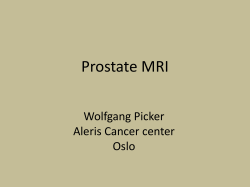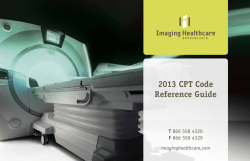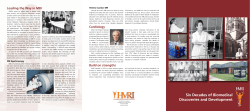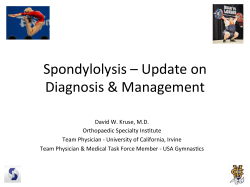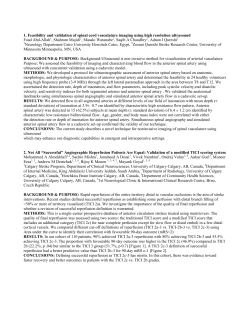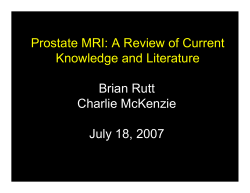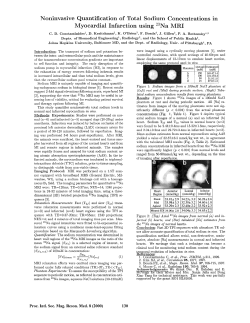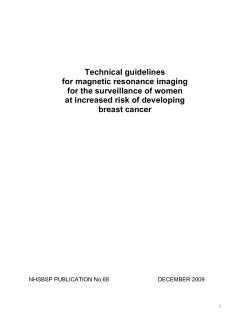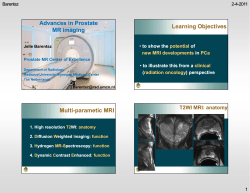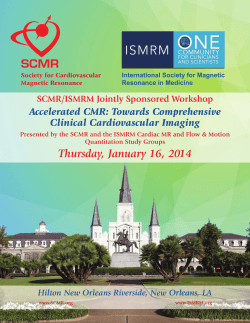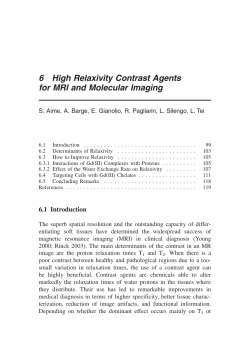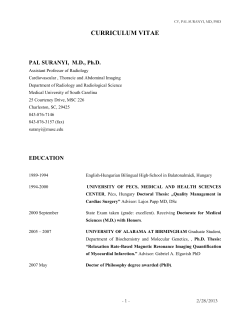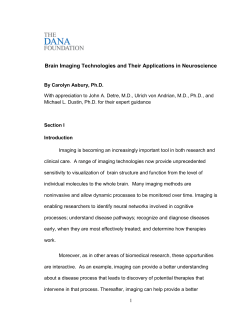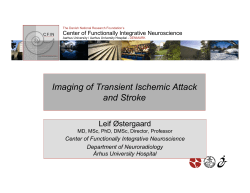
2
2 . Your Image Our Vision Your Choice Introduction This guide is meant to assist physicians when ordering imaging exams based on common clinical situations. The goal is to assist physicians with ordering the most optimal imaging study for their patients. We hope these guidelines will be useful in most clinical situations and beneficial for both the physician and patient. However, we know situations will arise that require a one on one consultation with a Radiologist. As needed, please feel free to consult our team of sub-specialty Radiologists. This will allow us to partner with you and determine the best approach for your particular patient. The contact information for each sub-specialty team is listed for your convenience. VRI PACS – Image/Report Portal Referring offices have the ability to access patient images and view reports online via our PACS Portal. If you need assistance with getting this set up for your practice, then please contact: Kellie Markovich – Marketing & Business Development Coordinator (910) 323-2209 / kmarkovich@valleyregionalimaging.com You can access our PACS Portal at: www.valleyregionalimaging.com If you experience IT related issues, then please contact Xodus Technology Professionals for assistance/support: Ted Best – Systems Engineer-Health IT|Radiology (888) 607-2414 Ext. 7000 / www.xodus-is.com VRI RIS - Scheduling Portal Referring offices have the ability to submit imaging orders online via our Scheduling Portal. Using the portal, you can schedule appointments directly, follow-up on scheduled and completed appointments, and pull patients reports. If you need assistance with getting this set up for your practice, then please contact: Kellie Markovich – Marketing & Business Development Coordinator (910) 323-2209 / kmarkovich@valleyregionalimaging.com 3 You can access our RIS Scheduling Portal at: www.valleyregionalimaging.com If you experience IT related issues, then please contact Xodus Technology Professionals for assistance/support: Ted Best – Systems Engineer-Health IT|Radiology (888) 607-2414 Ext. 7000 / www.xodus-is.com Table of Contents I. Special Considerations II. Breast Imaging III. Chest Imaging IV. Endocrine Disorders V. Gastrointestinal Imaging VI. Genitourinary System VII. Interventional Radiology VIII. Musculoskeletal Imaging IX. Neurologic Imaging X. Pediatric Imaging XI. Appendices Locations and Services Offered Affiliated Hospitals CRR Radiologists 4 for assistance/support: Ted Best – Systems Engineer-Health IT|Radiology (888) 607-2414 Ext. 7000 / www.xodus-is.com Table of Contents I. Special Considerations II. Breast Imaging III. Chest Imaging IV. Endocrine Disorders V. Gastrointestinal Imaging VI. Genitourinary System VII. Interventional Radiology VIII. Musculoskeletal Imaging IX. Neurologic Imaging X. Pediatric Imaging XI. Appendices Locations and Services Offered Affiliated Hospitals CRR Radiologists 4 Special Considerations Decreased Renal Function and Need for Contrast-Enhanced CT: e-GFR < 30 or serum creatinine of > 2: No IV contrast. e-GFR 30 - 60: Reduced dose of contrast and Visipaque 320. IV and oral hydration to reduce risk of contrast induced nephropathy. Risk Factors for Contrast–Induced Nephropathy: Baseline decreased renal function (creatinine > 1.5mg/dL) Dehydration Elderly Hypertensive nephropathy Diabetic nephropathy Multiple myeloma Repeat administration of contrast over short period of time Ionic high-osmolar contrast agents Nephrotoxic medications Patients with history of mild or moderate allergic reaction to iodinated IV contrast used in CT should be pre-medicated. 50mg of Prednisone PO 13 hours, 7 hours, and 1 hour before the IV contrast administration; plus, 50mg of Benadryl PO 1 hour before the IV contrast administration; plus, 50mg of Prednisone PO 6 hours after IV contrast administration. MRI should be considered for patients with prior severe allergic reaction to iodinated contrast based on the need of a contrastenhanced cross-sectional exam. 5 Decreased Renal Function and Need for Contrast-Enhanced MRI: eGFR < 30: No IV Gadolinium-based IV contrast unless absolutely essential. e-GFR 30 - 60: Gadolinium-based IV contrast dose of 0.1 mmol/kg or less. e-GFR > 60: Gadolinium-based IV contrast can be administered safely. [Please note: Dialysis patients are at a much higher risk for Gadoliniumbased IV contrast agent induced Nephrogenic Systemic Fibrosis (NSF)]. For Patients Unable to Follow Commands/Breathing Instructions: CT is less sensitive to motion than MRI. Pregnancy and Appendicitis: First and second trimester: U/S of the Right Lower Quadrant (RLQ) followed by MRI without contrast if U/S is non-diagnostic or equivocal. Third trimester: MRI without contrast. CT Abdomen and Pelvis with IV and oral contrast if MRI is unavailable. Pregnancy and Trauma: Initial work-up with Chest X-Ray, lateral X-Ray of the Cervical Spine, and U/S examination of the gravid uterus and abdomen (focused abdominal sonogram for trama-FAST). CT for hemodynamically stable seriously injured pregnant patient with blunt trauma. Pregnancy and Urolithiasis: U/S is recommended. Unenhanced CT if U/S is non-diagnostic. 6 Pregnancy and Pulmonary Embolism (PE) Imaging: Diagnostic Algorithm for Suspected PE in Pregnancy Suspected PE in Pregnancy Present CUS Leg Symptoms Absent CXR Negative Abnormal Positive Normal CTPA Nondiagnostic V/Q TREAT Negative Stop Technically Inadequate Positive CUS, CTPA TREAT Positive Negative Stop Diagnostic Algorithm flow chart delineated above provided by: http://radiology.rsna.org/content/262/2/635/F1.large.jpg CUS- Compression Ultrasound of the Lower Extremities. CTPA-CT Angiogram of the Pulmonary Arteries. Radiation dose reduction technique after the V/Q scan is hydration with frequent voiding to reduce fetal exposure form the urinary bladder. 7 Breast Imaging Breast Cancer Screening – Asymptomatic Women: Annual Mammography beginning at age 40. Breast Cancer Screening – High Risk Women: Risks include BRCA mutation, personal history of high-risk breast biopsy, or personal history of thoracic radiation age 10-30 years old. Annual Mammography beginning at age 40. Annual Breast MR (for patients with greater than 20% lifetime risk). Diagnostic Workup – Palpable Mass, Axillary Mass, Bloody Nipple Discharge, Skin Dimpling, or Nipple Retraction: Diagnostic Mammography. Breast Ultrasound. Breast MR – Indications: High risk screening. Local staging and contralateral screening in newly diagnosed breast cancer. Occult breast cancer in positive biopsy axillary lymph nodes or metastases, but negative mammograms. Implant rupture. Assessing response to neoadjuvant therapy. Problem solving. High Risk Screening Breast MR – American Cancer Society Recommends: BRCA mutation. First degree relative of BRCA mutation, but untested. Lifetime risk of 20-25% or greater. Radiation to the chest between age 10-30 years old. Li-Fraumeni, Cowden, or Bannayan-Riley-Ruvalcaba syndrome. First degree relatives. 8 Chest Imaging 1. Solitary Pulmonary Nodule: CT - Fleischner Society Recommendations Nodule Size (mm) Low-Risk Patient High-Risk Patient <4 No follow-up needed. Follow up CT at 12 months; if unchanged, no further follow up. >4-6 Follow up CT at 12 Initial follow up CT at 6-12 months; if unchanged, mo then 18-24 months if no further follow-up. no change. >6-8 Initial follow up CT at 6 Initial follow-up CT at 3 - 6 - 12 months; then 18 - months; then at 9 - 12 and 24 months if no change. 24 months if no change. >8 Follow-up CT at around Follow-up CT at around 3, 3, 9 and 24 months; 9 and 24 months; dynamic contrast-enhanced CT, PET, dynamic contrastand/or biopsy. enhanced CT, PET, and/or biopsy. Consider PET-CT Scan if 1cm or larger nodule. 9 2. Aortic Aneurysm: U/S for smaller sized or thin patients for detection. CT or MRI for larger or obese patients and for follow-up. 3. Aortic Dissection: CT Angiogram (CTA with and without Contrast) is used only for ACUTE dissection. Every effort should be made to reduce exposure to imaging radiation. MRI is used for surveillance imaging required for chronic dissection. MRI is also preferred for chronic dissection cases that have undergone surgical repair. 4. Interstitial Lung Disease: High-Resolution Chest CT protocol should be used. 5. Mediastinal Mass: CT chest with contrast should be the first study ordered for patients with an abnormal Chest X-Ray or clinical suspicion for mediastinal mass (other than substernal thyroid). MRI is best for problem solving. PET-CT Scan should be used for staging of lung cancer or malignant adenopathy. 6. Pleural Effusion: Chest X-Ray is best for detection or follow-up. CT with contrast can be used to characterize pleural effusion and underlying disease process. 10 7. Pulmonary Embolism: Chest X-Ray is performed to exclude other causes of symptoms. This assists in interpretation of Ventilation Perfusion Lung Scan (V/Q Scan). CT Angiogram of the pulmonary arteries (CTPA for PE). Current weight limit for Valley Regional Imaging (VRI) CT is 400 lbs. Current weight limit for Cape Fear Valley CT is 480 lbs. Patient can be on ventilator. Ventilation Perfusion Lung Scan (V/Q Scan) if patient has history of severe contrast reaction or renal insufficiency. Please refer to the Special Considerations section for additional guidelines regarding evaluation for suspected PE in pregnant patients. GU | Chest 11 Endocrine Disorders 1. Adrenal: Adenoma Clinical and laboratory work-up. CT Abdomen with adrenal mass protocol (without and with contrast) or MRI Abdomen without contrast. Incidentaloma Asymptomatic adrenal mass. CT Abdomen with adrenal mass protocol (without and with contrast) or MRI Abdomen without contrast. Pheochromocytoma Thorough clinical work-up. First imaging study: CT Abdomen/Pelvis and possibly Chest CT without contrast. MRI to further characterize abnormalities. Nuclear Medicine Neuroendocrine study (I-MIBG) for extraadrenal sites and metastatic disease. 2. Parathyroid Tumor: Tc 99m Sestamibi scan is exam of choice. 3. Thyroid: Solitary Palpable Mass - Euthyroid Patient U/S recommended for confirmation of origin and characterization (cystic or solid). Biopsy depending on size and appearance. Multinodular Gland on Physical Examination U/S recommended. 12 Biopsy if needed. Toxic Multinodular Goiter - Clinical Hyperthyroid 131-I Thyroid Scan and Uptake. Treat with I-131. Graves’ Disease - Clinical Hyperthyroid (Increased TSH) 131-I Thyroid Scan and Uptake. Treat with I-131. Evaluation for Metastasis - Patient with Thyroid CA I-131 Whole Body Scan. Treat with high doses of I-131. PET-CT or CT as indicated 13 Gastrointestinal Imaging 1. Acute Cholecystitis: U/S is recommended as the initial study. HIDA Scan: If diagnosis is equivocal, this should be performed to establish patency of cystic duct. If clinical symptoms warrant further investigation after negative U/S and/or HIDA, consider MRI. If common duct stones are suspected, consider MRCP. 2. Acute GI Bleeding: If endoscopy or NG tube aspirate is negative, then order radiolabled RBC scan If RBC scan is positive, consider visceral angiography. If RBC scan is negative, consider clinical monitoring since angiography will also be negative. 3. Appendicitis: U/S in infants, children, and pregnant or thin childbearing-age women is recommended as the initial study. Consider MRI if the U/S is non-diagnostic with strong clinical concern in children. If pregnant, refer to special considerations section. If not pregnant, use CT Abdomen and Pelvis with oral and IV contrast. 4. Bile Leak (Post Operative or Trauma): HIDA Scan. If T-Tube is present, then obtain T-Tube Cholangiogram. MRI/MRCP in selected cases. Typically, it is more accurate for chronic rather than acute bile leaks. 14 5. Biliary Obstruction (Jaundice): U/S is recommended as the initial study. If U/S shows dilated duct, use MRI/MRCP or CT without and with contrast (pancreatic mass protocol) to differentiate between common duct stone and pancreatic head tumor. HIDA Scan may play role in functional evaluation of benign appearing dilated duct. 6. Blunt Abdominal Trauma: In hemodynamically stable patient, CT Abdomen and Pelvis with IV contrast is recommended as the initial study. 7. Chronic Cholecystitis: U/S is recommended as the initial study. HIDA Scan with Gallbladder Ejection Fraction for gallbladder dysfunction as cause of abdominal pain. 8. Chronic GI Bleeding: Upper/Lower Endoscopy is recommended as the initial study. Consider CT Enterography (CTE). If all studies are negative, then Angiography may find angiodysplasia. Meckel’s Scan may be useful in children with lower GI bleeding. 9. Dysphagia: Esophagram (Barium Swallow) is recommended as the initial study. Suspicious findings should be followed by endoscopy. If swallowing dysfunction/aspiration is suspected, request Speech Pathology Swallowing Evaluation and they will recommend Modified Barium Swallow if needed. 15 10. Focal Liver Lesions: MRI Abdomen without and with contrast is the preferred study. CT Abdomen without and with contrast is a lower cost alternative, but less desirable in terms of ionizing radiation. CT should be used for patients with MRI contraindications. 11. Gallstones or Bile Duct Stones (Choledocholithiasis): U/S is recommended as the initial study. If gallstones are very small on U/S, consider preoperative MRI/MRCP, as risk of common bile duct stones is greater with small gallstones. 12. Hepatosplenomegaly: U/S is recommended as the initial study. If volumetric estimation and monitoring is needed, MRI is preferred. 13. Inflammatory Bowel Disease: CT Enterography (CTE) is the primary modality for confirmation of a new diagnosis of Crohn’s Disease. Routine CT Abdomen and Pelvis is preferred for recurrent disease, but be mindful of cumulative radiation dose. 14. Pancreatic Mass: CT Abdomen without and with contrast using pancreatic mass protocol is the first choice for evaluation of a pancreatic mass. MRI Abdomen without and with contrast can be more informative for characterization of pancreatic lesions. 15. Small Bowel Obstruction (SBO): Acute abdominal series is recommended as the initial study. 16 If non-diagnostic, routine CT Abdomen and Pelvis with Oral and IV contrast may be definitive and can direct surgical planning. 17 Genitourinary System 1. Adnexal Mass: U/S is recommended as the initial study. Pelvic MRI for characterization if further imaging is required. 2. Dysfunctional Uterine Bleeding: U/S is recommended as the initial study. Pelvic MRI should be performed for more detailed visualization if uterine artery embolization or other interventions are planned. 3. Ectopic Pregnancy: U/S is recommended. 4. Obstructive Uropathy: A KUB X-Ray for stones is recommended as the initial study. CT Abdomen and Pelvis without IV or oral contrast using renal stone protocol. For recurrent obstruction after initial CT, use follow-up KUB plain films and U/S. Patients with chronic stone disease and recurrent obstructive uropathy are best managed with the judicious application of CT, U/S, KUB plain films, and occasionally MRI. Be mindful of cumulative radiation dose. To evaluate presence and degree of obstruction, use Radionuclide Renogram with Lasix (MAG 3 Lasix Renogram). Intravenous Pyelogram (IVP) can be performed, but it has a higher radiation dose. 5. Painless Hematuria: A KUB plain film for stones is recommended as the initial study. 18 CT Urogram (CT Abdomen and Pelvis without and with Contrast) for suspected urothelial neoplasm or follow up for recurrent/metachronous urothelial neoplasm. MR Urogram can be used in select patients with history of severe iodinated contrast reaction. 6. Penile Mass: MRI is the preferred modality. 7. Prostate Cancer: MRI is used for local and regional staging. Bone Scan for bone metastases. 8. Renal Mass: U/S is recommended to determine cystic vs. solid in thin patients. Indeterminate lesions seen on U/S or single phase CT can be characterized as solid or cystic using CT abdomen with renal mass protocol (without and with contrast) or MRI without and with contrast. 9. Renal Failure: U/S can be used to assess renal size, echotexture, cortical thickness, and hydronephrosis. If hydronephrosis is seen on U/S, then non-contrast CT can help determine the cause. 10. Suspected Renovascular Disease: MR Angiography should be considered first. It has high sensitivity and specificity, and used no radiation; however, contrast is used and it is slower (more need for sedation). Also, it is most expensive. 19 CT Angiography would be the second choice. It has high sensitivity and specificity, and it is less expensive then MRI. It is also much faster (less need for sedation); however, contrast is used and the radiation exposure must be considered. Captopril Renogram is the third alternative. No IV contrast is required; however, it has lower sensitivity and specificity, it is slower, somewhat expensive, and also exposes the patient to radiation. 11. Scrotal Imaging: U/S is recommended. 20 Interventional Radiology 1. Compression Fractures: MRI before treatment to evaluate for edema in acute or subacute fractures is recommended. With Vertebroplasty, methyl methacrylate (aka cement) is injected directly into a fractured vertebral body, resulting in pain relief by stabilizing the fracture. With Balloon Kyphoplasty, a balloon is utilized to create a void for the cement as well as to attempt to correct the fracture deformity, obtaining fracture reduction and fixation. Painful bone tumors involving the vertebrae; metastatic disease. 2. Deep Venous Thrombosis: Catheter Directed Thrombolysis is suggested for acute to subacute thrombus (optimal at less than 4 weeks in age). Suggested for young patients with large clot burden or worsening clot burden despite adequate anti-coagulation, or those with severe symptoms with risk of causing ischemia of lower extremity. 75% can be performed in single session. Some may require overnight infusion in ICU, especially patients with more chronic thrombus. 3. Image Guided Biopsy or Drainage: U/S guidance is usually used for biopsies of thyroid nodules, head and neck nodules, and lymph nodes as well as for thoracentesis and paracentesis. CT guided biopsy is used for lung masses, abdominal or pelvic masses, or bone lesions. 21 . CT guidance is usually used for abscess and empyema drainages, chest tube placement for hemothorax, or loculated pleural fluid collections. 4. Interventional Oncologic Radiation Therapies: Hepatic Artery Chemoembolization is an Angiogram of the hepatic artery with direct injection of chemotherapy into the tumor blood supply. Used with primary liver cancer (Hepatocellular Carcinoma, HCC), or liver dominant metastatic disease. Tumor-Multifocal, > 5cm in size if solitary, little to no extrahepatic disease. CT or MRI Abdomen should be performed for planning. Cryoablation is CT guided percutaneous treatment of renal cell carcinoma. Tumor-Solitary, usually < 3cm in size. Used with patients with limited renal function/reserve (solitary kidney, chronic renal disease, not yet on HD, syndromes with high risk of multiple tumors). 5. IVC Filters: Indicated for patients with lower extremity DVT or PE with absolute contraindication to anti-coagulation, major complication to anti-coagulation, or failed anti-coagulation. Good to use with high risk patients (trauma, burn), prior to orthopedic or bariatric surgery, or with cancer. Patients with poor cardiopulmonary reserve with large DVT. Retrievable or permanent filters may be placed. Risk of causing DVT increases after 2 years; therefore, recommend placing retrievable filters and attempting to remove them within 6 months. 22 6. Peripheral Vascular Disease: Non-invasive arterial evaluations include Ankle Brachial Index (ABI), Segmental Pressure Measurements, Arterial Doppler Waveforms, and Pulse-Volume Waveforms. Used for screening high risk patients, for mild or moderate symptoms, or to follow disease progression. CT Angiogram or MR Angiogram indicated for acute ischemia, moderate to severe symptoms, or with atypical symptoms. Angiogram indicated for patients with moderate to severe disease, or with those already treated with more conservative measures. 7. Uterine Fibroids: Uterine artery embolization is an alternative to surgery for the treatment of symptomatic uterine fibroids. MRI Pelvis without and with contrast is recommended. 8. Venous Access (Port, PICC, Hickman): Venous access is an important part of outpatient chemotherapy and long-term antibiotic administration (e.g., osteomyelitis and Lyme’s treatment). 23 Musculoskeletal Imaging 1. AVN Hip: Plain X-Rays: AP Pelvis and Frog-Leg Lateral of symptomatic hip. X-rays negative or equivocal proceed with MRI. X-rays positive; proceed with MRI if information is needed on other hip or for surgical planning. If MRI is contraindicated, then proceed with Bone Scan with SPECT for radiographically occult AVN. 2. Joint Injections: The indications for joint or soft tissue aspiration and injection fall into two categories: diagnostic and therapeutic. Diagnostic indications include the aspiration of fluid for analysis and the assessment of pain relief and increased range of motion as a diagnostic tool. A common diagnostic indication for placing a needle in a joint is the aspiration of synovial fluid for evaluation of infection or inflammatory and crystal-induced arthropathies. A second diagnostic indication involves the injection of a local anesthetic to confirm the presumptive diagnosis through symptom relief of the affected joint. Therapeutic indications include the delivery of local anesthetics for pain relief and the delivery of corticosteroids for suppression of inflammation. Therapeutic indications for joint or soft tissue aspiration and injection include decreased mobility and pain, and the injection of medication as a therapeutic adjunct to other forms of treatment. Therapeutic injection with corticosteroids should always be viewed as adjuvant therapy. 24 These injections should never be undertaken without diagnostic definition and a specific treatment plan in place. 3. Joint Replacements: Plain X-Rays Initial exam for loosening or infection; however, X-Ray has limited sensitivity/specificity. Bone Scan May be positive in asymptomatic patients up to 2 years post-op. Joint Aspiration Effective for infection diagnosis if Abx held more than 2 weeks. Difficult Cases Use combined WBC and Marrow Nuclear Medicine imaging. CT and MRI Better than plain X-Ray for granulomatous disease detection. CT is useful for component rotational alignment. 4. Metastatic Bone Disease: Plain X-Rays For known primary and focal pain. WB Bone Scan For primary detection (unless PET-CT performed for staging). Plain X-Rays for Bone Scan abnormalities. MRI, CT, or PET-CT for non-diagnostic X-Rays. MRI without contrast for spine disease. 25 5. Image Guided Biopsy: Use for diagnosis. Use with suspected recurrence. Use to differentiate mets. vs. osteonecrosis in previously irradiated bone. 6. Stress Fracture: Plain X-Rays are recommended. If X-Rays are negative and it is non-emergent, then repeat X-Rays in 10-14 days. MRI is best in terms of sensitivity/specificity. Useful in athletes, elderly and those who depend on injured limb to work. MRI without contrast unless ambiguous findings or associated soft tissue mass. CT is occasionally needed to confirm diagnosis, particularly for pelvic/sacrum insufficiency fracture. 7. Suspected Osteomyelitis of the Foot in Diabetics: Clinical suspicion with or without ulceration. Plain X-Rays. MRI without and with contrast if X-Rays are negative. (MRI without contrast for low GFR.) If MRI contraindicated, 3-Phase Bone Scan & WBC Scan. 8. Soft Tissue Swelling - Questioning Charcot or Infection: Plain X-Rays. 3-Phase Bone Scan for negative X-Rays and low suspicion for infection. MRI for negative X-Rays and moderate risk of infection. Use pathway 1 for suspected osteo. in other anatomic sites without/with D.M. 26 Neurologic Imaging 1. Acute Head/Face Trauma: CT without contrast is first choice. MRI is sometimes used for evaluation of the brain in the setting of unexplained symptomology. No role for plain X-Rays. 2. Acute Spine Trauma: Plain X-Rays are best used when the suspicion of significant injury is low. CT is the quickest and most accurate in acute setting to exclude fracture. CT is also used when plain X-Rays are equivocal or to further evaluate abnormalities noted on X-Rays. MRI is used when neurologic symptom or deficit is not explained by plain X-Rays or CT. MRI is also used to evaluate the spinal cord in the setting of known fractures and with the unresponsive patient. 3. Cerebral Aneurysms: CT without contrast for acute presentation when subarachnoid hemorrhage is suspected. MRI and MRA Head (usually without contrast) in non-emergency situations. Head CTA (CT angiography with contrast) when in acute setting for diagnosis and operative planning, or if MRI is contraindicated in non-emergent setting. Angiography used to further evaluate known aneurysm, or to detect tiny aneurysm when MRA/CTA is negative and clinical suspicion remains very high. 27 4. Cerebral Metastases/Cerebral Tumor: MRI with gadolinium is most sensitive and specific, request perfusion especially for treated (irradiated) tumors. CT with and without contrast when MRI is contraindicated. PET-CT. 5. Chronic Back Pain: MRI of the lumbar spine without contrast. CT Myelogram if MRI is contraindicated or nondiagnostic. Non-Myelographic CT can be performed as well if Myelogram is also contraindicated, but this is not as sensitive or specific. If suspicion of tumor (metastatic disease), infection, or if patient is immunosuppressed, MRI with and without contrast. In the post-operative spine, MRI with and without contrast to evaluate for scar tissue. 6. Chronic Intractable Epilepsy or New-Onset Seizures Children/Teens: MRI is first choice. Please include "epilepsy/seizure" when requesting the study (High resolution coronal T2-weighted imaging of the hippocampi will be added for detection of mesial temporal sclerosis). If not typical febrile seizure, CT in the acute setting to exclude hemorrhage, mass, or other cause of seizure. 7. New-Onset Adult Seizures: MRI is first choice. Contrast is generally added for adults with new seizures. CT in the acute setting to exclude intracranial hemorrhage or other acute process, or if MRI is contraindicated. 28 8. Dementia: PET-CT is the most sensitive test for Alzheimer’s disease; Medicare approved indication, CPT 78608. MRI is most useful in excluding other causes of dementia (e.g. multi-infarct dementia). CT should be used if MRI is contraindicated. 9. Demyelinating Disease: MRI with and without contrast is exam of choice. Please specify suspicion of, or history of, demyelinating disease when requesting the study (Sagittal and/or coronal FLAIR and STIR imaging will be added). CT with contrast when MRI contraindicated. 10. Encephalitis: MRI with and without contrast is best. CT with contrast if MRI is contraindicated. 11. Nasal CSF Leak (CSF Rhinorrhea): Unenhanced high-resolution facial bone CT in the setting of rhinorrhea suspicious for CSF leak. CT cisternography (CT of the sinuses after intrathecal injection of myelographic contrast) may be used to document the specific location of the leak when needed. Radionuclide cisternogram, (measuring activity in cotton pledgets inserted by ENT service in the nasal cavities after intrathecal injection of radionuclide) for slow leak. 12. Normal-Pressure Hydrocephalus: MRI to evaluate for other causes of symptoms, findings to correlate with clinical diagnosis of NPH, or to evaluate CSF flow dynamics (if specifically requested). 29 CT used when MRI is contraindicated. Radionuclide cisternogram often used. 13. Sellar and Juxtasellar Lesions: MRI with and without contrast is exam of choice. Please specify Pituitary MRI when requesting the study (High resolution T1 weighted imaging of the pituitary without and with contrast will be added). 14. Spinal CSF Leak: Radionuclide cisternogram is first choice. MRI may be used to clarify etiology of leak if leak is demonstrated in a specific location on Radionuclide cisternogram. 15. Stroke: CT without contrast is first choice in the acute setting. After CT, MRI can be performed to confirm and better characterize acute infarctions, old infarctions, and chronic ischemic disease. MRI is also superior to CT for detection of posterior fossa infarctions, very early infarctions, or small infarcts. MRI is also superior to CT in the detection of mimickers of ischemic disease. MRA is used to evaluate vascular luminal compromise. CTA if MRA is contraindicated. 16. Vascular Malformations: Unenhanced CT used for acute presentation when hemorrhage is suspected. MRI with MRA Head (usually without contrast) in non-emergency situations. CTA Head (CT angiography with contrast) when MRI is contraindicated, or in acute setting. 30 Angiography can be used to further evaluate vascular malformation detected by MRI/CT, or when MRI/CTA is negative and clinical suspicion remains very high. 17. Vasculitis: MRI Head with MRA (usually without contrast) in non-emergency situations. CT Head with CTA (CT angiography with contrast) when MRI is contraindicated. Angiography used when MRI/CT is negative and clinical suspicion remains very high. 31 Pediatric Imaging 1. Abdominal and Pelvic Masses: Plain X-Rays (bowel gas patterns/calcifications or constipation). After plain X-Rays, U/S is primary modality for evaluation of an abdominal or pelvic mass. For older pediatric patients with indeterminate or non-diagnostic U/S, use CT or MRI. 2. Constipation (r/o Hirschprungs): Order un-prepped single contrast barium enema. GI/Rectal bleeding: Single contrast barium enema (must have bowel prep prior to exam). 3. Failure to Thrive: UGI and small bowel follow through. 4. Hip Instability/Dysplasia: If under 6 months, perform Hip U/S. If over 6 months, perform AP/Frog-Leg Pelvis X-Ray. Hip dysplasia: If under 6 months, order Hip U/S. If over 6 months, order AP/Frog-Leg Pelvis X-Ray. This demonstrates both hips on the same image for comparison. Abnormality of neonatal back (sacral dimple, spinal hemangioma, hairy patch): If under 6 months, order Spinal U/S to be followed by AP/Lateral Lumbosacral Spine X-Ray. If over 6 months, order sedated non-contrast MRI. 5. Infantile Emesis: If pyloric stenosis is suspected, do Pyloric U/S. 32 If bilious emesis, then suspect obstruction and/or malrotation and do urgent UGI series followed by Gastroview contrast enema if needed. If excessive GE reflux is suspected, consider UGI to exclude anatomic causes. If there is emesis plus failure to thrive, do UGI and small bowel follow through. 6. Non-Accidental Trauma (NAT): If under two years of age, obtain NAT osseous survey plus noncontrast head CT. If over two years of age, obtain Chest X-Ray. Then, consider additional plain X-Rays and non-contrast Head CT as guided by history and physical findings. 7. Refusal to Bear Weight: AP/Frog-Leg Pelvis and affected extremity. If hip effusion is suspected at any age on physical exam or plain X-Rays, then obtain Hip U/S. 8. UTI Imaging: Fluoroscopic VCUG and Renal U/S are recommended. If there is a need to document pyelonephritis or renal scarring, then order Nuclear Medicine Renal Cortical scan (DMSA). 9. Pediatric Bowel Prep: Clear liquids for 24 hours prior to examination. Magnesium Citrate PO: 2 doses are needed. First dose at 3pm or after school. Second dose at bed time the night before the test. 33 Magnesium Citrate Dose Chart: Age Amount < 1 yr. none 1 - 3 yrs. 1.5 oz. 3 - 5 yrs. 2.5 oz. 6 - 8 yrs. 3 oz. 9 - 12yrs. 4 oz. 13 - 18yrs. 5 oz. Clear liquids up until four hours before test, then no food or drink for four hours before the test. 34 Locations and Services Offered Valley Regional Imaging (VRI) 3186 Village Drive, Suite 101 Fayetteville, NC 28304 (910) 323-2209 www.valleyregionalimaging.com Carolina Regional Radiology (CRR) – Interventional Radiology Clinical Practice 1301 Medical Drive Fayetteville, NC 28304 (910) 486-5700 www.crrnc.com Carolina Regional Radiology (CRR) – Angier Imaging Center 169 Rawls Road Angier, NC 27501 (919)331-2001 www.crrnc.com Affiliated Hospitals Cape Fear Valley Medical Center 1638 Owen Drive Fayetteville, NC 28304 Betsy Johnson Regional Hospital 800 Tilghman Drive Dunn, NC 28335 Columbus Regional Healthcare System 500 Jefferson Street Whiteville, NC 28472 35 Compassionate Care, Quality Imaging Harry Ameredes, MD Terri Zacco, DO David Fisher, MD David Allison, MD Richard Falter, MD Richard Roux, MD Max Faykus, MD Mark Zalaznik, MD Jeffrey Kotzan, MD George Binder, MD Leroy Roberts Jr., MD Grant Yanagi, MD James Shearer, MD Tereza Poghosyan, MD Fred Caruso, MD Sheryl Jordan, MD Demir Bastug, MD Thomas Meakem III, MD Beverly Davis, MD Frank Graybeal Jr., MD Ali Nasim, MD Bruce Distell, MD
© Copyright 2025

